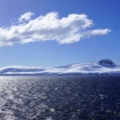There are no land animals in Antarctica, the continent is inhabited mainly by microbes, fungi and algae. Even on the cold beaches of Antarctica there are not many animals, but those that occur there are original. Meet the most frequent visitors to Antarctic beaches – penguin and sea leopard.





















Charming and clumsy on land, penguins mate for life. In one reproductive cycle, they have only one egg, but it is quite solid. Penguin eggs, depending on the penguin species, can weigh up to half a kilo. The egg is incubated for up to two months, mainly by the male. To separate the egg from the ground, penguins build nests from pebbles. There is not too much choice, there are no plants and sometimes stones as a cure, snow and solid rock around. In order not to starve to death, penguins change. Stretching paws or changing parents must be done quickly, first of all so that the egg does not freeze, but also because penguins gathering in the neighborhood only lurk for precious pebbles and unscrupulously steal them from the nests of inattentive parents. Brawls are the order of the day, the thief quickly escapes with the stolen pebble and the victim basically does not chase him, because the egg could freeze at that time! The scream and lament of the robbed penguin is very loud and the shame of the thief is none…

A less sympathetic animal patrolling the waters of the Antarctic Ocean is the sea leopard (not to be confused with the sea lion!). The leopard seal, also called the Leopard Amphitrite, is a large, spotted seal with large teeth. It can reach a size of up to 3.5 meters and a weight of up to 600 kg. The animal is an extremely fast and efficient killer, the only predator that threatens it in Antarctic waters is the killer whale. A ruthless killer of cute penguins, he kills not only out of necessity but also for fun by tossing the victim or hitting it on the surface of the water. The leopard’s teeth are built in such a way that it is able to feed on both krill, where the back teeth help to strain the water, and cut and tear meat. The shape of the jaw allows it to open its mouth wide, and the structure of the cervical spine makes it easy to pull his head back and hit it in an attack in a snake-like manner. The leopard will also not let other seals pass, it will also hunt a man if he finds himself in the water. But on land or floe you can not feel safe either, the sea leopard jumps out of the water even for 2 meters. By nature, it is an aggressive animal, it also willingly attacks the pontoons of research station employees. There is a known case of an attempt to pull a Scottish researcher from ice floes. The leopard bit him twice in the leg trying to pull him into the water, he gave up only when the Scotsman’s companions scared the animal away with kicks to the head. A successful leopard attack on a person took place in 2003. Amphitrite attacked Kirsty Brown, a biologist. Kirsty was swimming in a mask and with a pipe when she was attacked by an Amphitrite, pulling 60 meters under the water. The woman could not be saved. Leopards often swim up to diving people, bringing them hunted penguins like a dog. According to scientists, this is not a gesture of sympathy towards man, but a necessity – a leopard is not able to swallow a penguin whole, it must tear its victim apart. So he is looking for another predator to hold his prey. But beware, from a fellow diner you can quickly become a main course!




